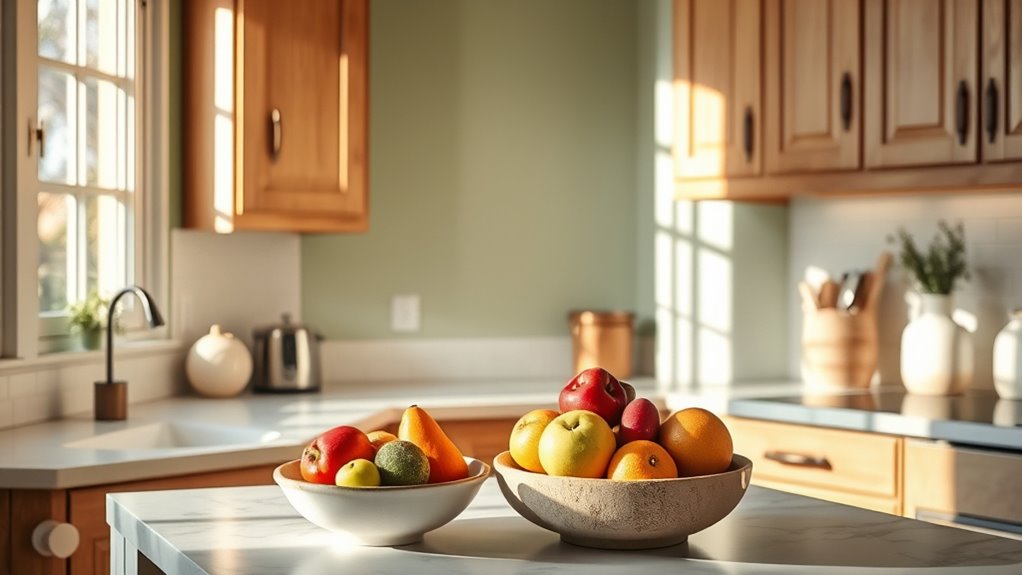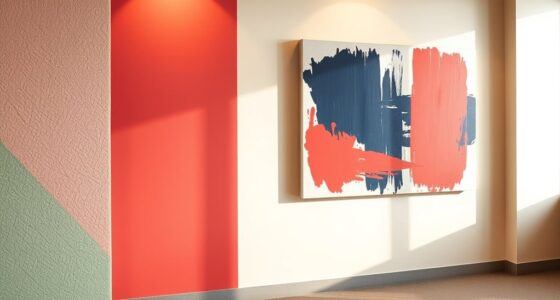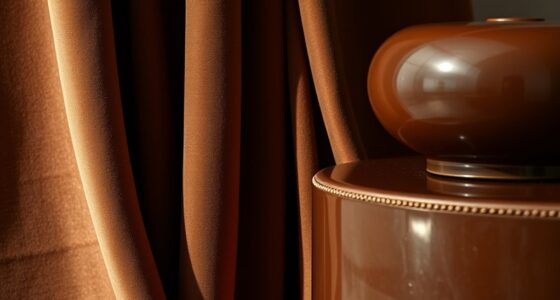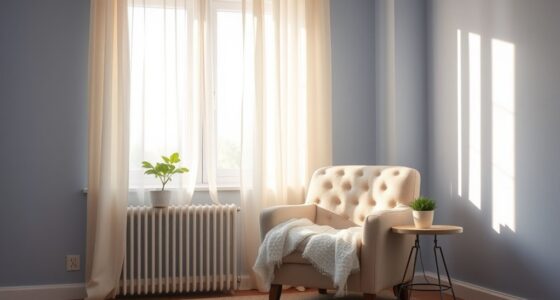To encourage eating without overstimulating, opt for soft, muted tones like gentle beiges, warm taupes, or natural earth shades. Incorporate food-inspired colors such as muted oranges, soft blush, or terracotta to subtly stimulate appetite while maintaining a calming environment. Avoid bright, neon hues that can cause chaos or distraction. Adding natural elements like plants and warm accents enhances the space’s relaxing vibe. Keep exploring for more tips to create the perfect inviting kitchen.
Key Takeaways
- Use soft, muted tones like gentle beiges and earth shades to create a relaxing, inviting dining environment.
- Incorporate warm, food-inspired colors such as terracotta and muted orange to stimulate appetite without overload.
- Avoid overly bright or neon hues that can cause overstimulation and distract from mindful eating.
- Integrate natural colors like greens, browns, and yellows to reinforce healthy choices and calm the mind.
- Add natural elements like plants or wood accents to enhance tranquility and promote a peaceful mealtime atmosphere.

Choosing the right colors for your kitchen can considerably influence your appetite and eating habits. When you pick colors thoughtfully, you create an environment that naturally encourages you to enjoy your meals without feeling overwhelmed or overstimulated. Bright, overly vibrant hues might seem appealing at first, but they can sometimes be too stimulating, making you feel restless or distracted during mealtime. Instead, opting for colors that are warm, calming, and inviting can help you focus on your food and savor each bite.
Choosing warm, calming colors in your kitchen enhances your appetite and creates a relaxed, enjoyable dining experience.
Soft, muted tones like gentle beiges, warm taupes, and subtle earth tones foster a sense of comfort and relaxation. These shades do more than just look good—they set a mood that promotes a leisurely eating experience. When your kitchen walls and accents are in these calming hues, you’re more likely to sit down, take your time, and enjoy your meal rather than rushing through it or feeling anxious. The goal is to find a balance between stimulating your appetite and avoiding overstimulation.
Colors like warm terracotta, soft blush, or muted orange can stimulate your hunger without overwhelming your senses. These hues evoke warmth and coziness, encouraging you to feel more at ease during mealtime. They subtly activate your appetite and make your kitchen feel welcoming, but they don’t bombard your senses as more saturated shades might. Avoid overly bright or neon colors, which can create a sense of chaos or agitation, detracting from your enjoyment of food. Instead, choose shades that are rich enough to be inviting but subdued enough to maintain a peaceful atmosphere.
Additionally, incorporating natural colors inspired by food and nature can reinforce your desire to eat healthily and mindfully. Think of leafy greens, soft browns, and gentle yellows that resemble fresh produce and natural elements. These colors can subtly remind you of nutritious choices and encourage a more mindful approach to eating. When your kitchen environment is visually harmonious, it becomes easier to focus on your meal and enjoy it fully. Creating a self-watering plant pot setup in your kitchen not only enhances the aesthetic but also brings a calming, natural element that can subtly influence your mood and appetite.
Frequently Asked Questions
How Do Lighting Choices Affect Appetite in a Kitchen?
Lighting choices can markedly influence your appetite in the kitchen. Bright, warm lighting creates a cozy, inviting atmosphere that encourages you to dine comfortably, while harsh, overly bright or cool lights may reduce your desire to eat. Dimmer, softer lighting helps you relax and enjoy your meals without overstimulation. So, opt for warm, natural tones and adjustable lighting to foster a welcoming environment that naturally stimulates your appetite.
Can Wall Art Influence Eating Habits in the Kitchen?
Yes, wall art can influence your eating habits in the kitchen. Bright, cheerful images or calming nature scenes can make mealtime more enjoyable, encouraging you to eat more mindfully. Avoid cluttered or overly stimulating art that might distract or suppress your appetite. Instead, choose artwork that creates a welcoming atmosphere and promotes relaxation, helping you focus on your food and enjoy your meals more fully.
Are There Specific Textures That Promote Mindful Eating?
Think of your kitchen as a serene pond where gentle ripples guide your mindful eating. Textures like smooth ceramics, soft linens, or natural wood encourage you to slow down and savor each bite. These tactile elements act as subtle signals, inviting you to stay present and engaged with your food. By choosing calming, varied textures, you create an environment that nurtures awareness and transforms eating into a mindful, pleasurable experience.
How Does Kitchen Layout Impact Food Intake?
Your kitchen layout directly influences your food intake by shaping your habits and accessibility. A well-organized space with designated areas for cooking, eating, and storage encourages mindful choices and prevents overeating. Keep frequently used items within easy reach, and avoid clutter that can lead to impulsive snacking. By designing your kitchen thoughtfully, you create an environment that supports healthier eating patterns and reduces unnecessary snacking.
Do Window Treatments Affect the Mood for Eating?
Yes, window treatments can influence your mood while eating. Imagine sunlight streaming in through sheer curtains, creating a calm, inviting atmosphere that makes mealtime more enjoyable. Dark or heavy blinds might feel oppressive, dampening your appetite. The right window coverings subtly set the tone, encouraging you to relax and savor your food without overstimulation. So, choose your treatments wisely—they can genuinely enhance your dining experience.
Conclusion
By choosing warm, inviting kitchen colors, you turn your space into a cozy garden where your appetite blossoms. These hues act like gentle whispers, coaxing you to savor every bite without overwhelming your senses. Think of your kitchen as a canvas painted with colors that nurture your hunger and calm your mind, creating a harmonious dance between taste and tranquility. So, fill your culinary haven with shades that invite you to eat, enjoy, and unwind.









